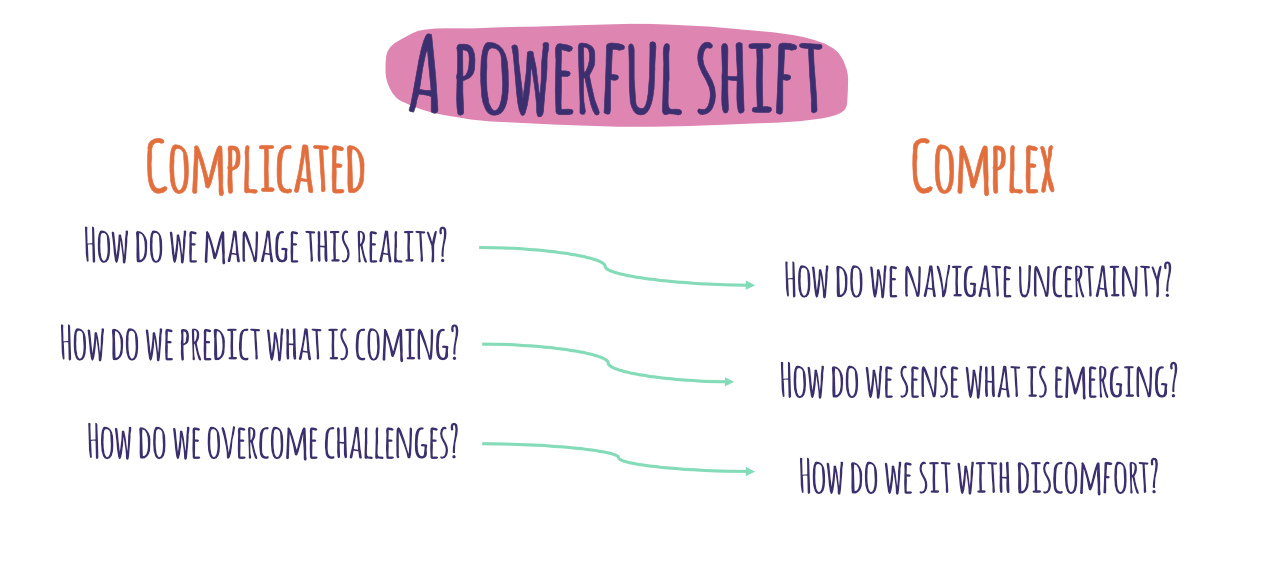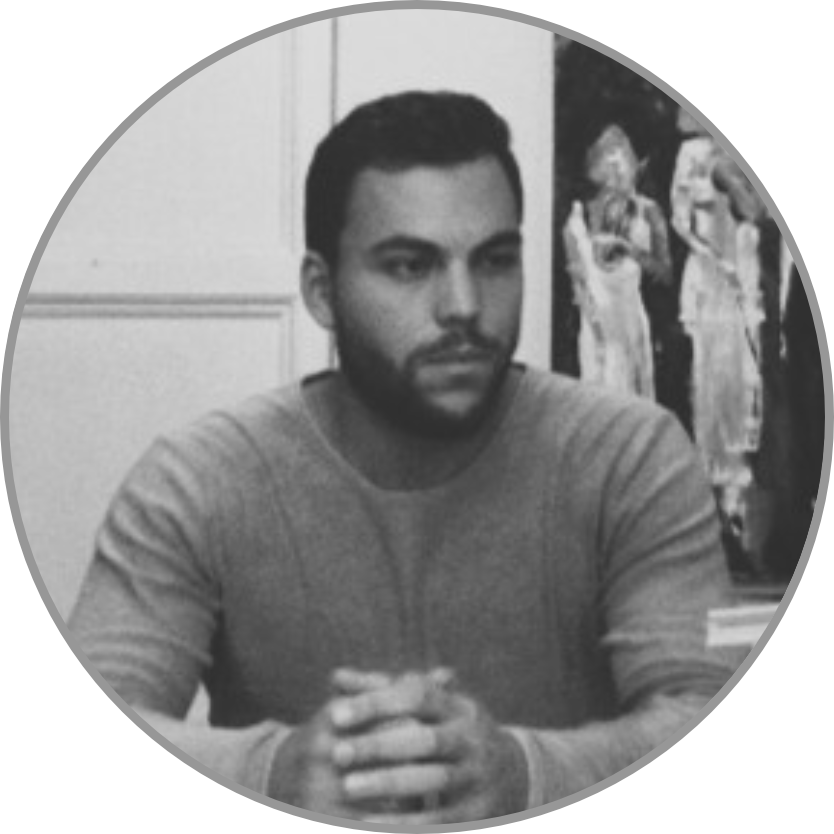VUCA
HOW DO WE NAVIGATE THIS NEW REALITY?
“Cynefin” translates from Welsh to “The place of your multiple belongings”. It is a sensemaking framework born from complexity theory, describing the important differentiation between complicated and complex realms.
COMPLICATED REALM
COMPLEX REALM
In the complex realm, we talk about dispositional systems, where everything about the future is unknown and cannot therefore be predicted and much less controlled. No expert can simply write a manual and thereby reliably solve the issue in front of her/him, as problems cannot be solved anymore via application of past experiences or evidence-based practices. Climate, biological cells, traffic, and humans themselves are all examples of things that play in the complex realm. The million-dollar question is: how to act in a system which is that uncertain? The truth is, we do not know. But there is thought emerging as to what could be promising pathways: 1) Asking different questions, 2) Taking multiple perspectives, and 3) Sensing the system. We will deep-dive into those.
THREE PATHWAYS FOR LEADERSHIP IN COMPLEXITY

ASKING DIFFERENT QUESTIONS
Fast shifts in our reality often require quick reactions. Leaders especially experience the burden of solving arising issues. With good intent to protect their teams and moving quickly, they often find themselves in the mode of prescribing solutions. It is an interesting question to think about what modus operandi needs to emerge in leadership collectives to foster a culture of deliberate development in organizations.
A first reflection is the curious pathway of overcoming their innate “helper syndrome” and transforming the own leadership towards providing greater space for exploration. Over time, the exploration of one’s inner world will form a whole new understanding of our true Self as well as the world that surrounds us, and the intimate connection between those two elements.
When you talk, you are only repeating what you already know. But if you listen, you may learn something new.
–
The Dalai Lama
For organizations looking at creating a culture of empowerment this evolution will be key, for one can only take true charge in the presence of clarity regarding ones inner and outer world.
How can this look like at a concrete example?
Questions in the realm of…
- Solution: “Have you tried doing X? I`ve had great experiences with this.”
- Solution Space: “What options do you see? What could you picture working well?”
- Space: “What does this do with you? In what way does this matter to you personally?”

TAKING MULTIPLE PERSPECTIVES
By nature, perspectives are no truth. They are a partial view of reality born from our subjective judgement. But in fact, they are much more than that, they are the stories we tell ourselves. Stories so powerful, that they determine our every thought and every action. Since our environment is so complex, we are in need of reducing the vast amount of information into more digestible bits. Usually, we do not limit ourselves to simply saving these bits of information, but we go a step ahead and categorize them, attach judgements to them. Good vs bad, useful vs useless, “I like” vs “I don’t like”, and so the list goes on.
This is how our stories are born. Now, stories can be incredibly useful. They have served us ever since as a source of meaning and a pathway for understanding of our world. Since our ancestors we have been elevated and connected by our stories. But is there a way that our stories could be limiting us? That they could cloud our judgement? And if so, how do we find out that we got “trapped” in our own story? Especially since we act upon them, we must look into the mirror honestly, and scrutinize our own perception of reality.
Perception is merely reality filtered through the prism of your soul.
–
Christopher Ray
We ask ourselves “Is my story true or is my story simple to a degree that I cannot see clearly anymore?”. Jennifer Garvey Berger`s great hand-on advice on how to unlock the trap of our simple stories is to make them more complex. For instance, ask: “How is this (annoying and frustrating) person a hero?”. When you realize that you’re carrying a simple story about a person or a group of people, it can be useful to name the role you think they’re playing and then intentionally switch the role and see what that allows.A powerful way to get started on this is to write down simple stories you hold about yourself, regarding a situation, or with reference to other people. Write them as short, simple forms of thought. Afterwards, go one by one and ask yourself: “Is this story really true? Is there a part to this that I left out/ignored? Is there another way to look at this?”. If you want to try to debunk some of our simple stories in a group, the perceptual position exercise can be great fun.
And a great side-effect? Scrutinizing our simple stories will lead us to telling stories that are closer to whatever constitutes “truth”. It sharpens our mind and puts forth in the world something real. Check out Dr. Jordan Petersons short inspiring speech on the importance of speaking the truth:
Taking the easy way out or telling the truth – those are not merely two different choices. They are different pathways through life. They are utterly different ways of existing.
–
Jordan B. Petersons
SENSING THE SYSTEM
“Sensing” and “Managing” are fundamentally different. The latter necessitates activity to keep things under control, whereas the former simply requires an observant eye. The reason why all too often we go into managing-mode is that we cannot bear the tension of something we see as unresolved. We see tensions as something negative, to be dissolved as quickly as possible. Unfortunately, in our complex world we are constantly confronted with so many tensions of different kinds that we feel we never manage to “catch-up”, despite our best efforts.
The haste of running in managing-mode over prolonged periods of time eventually leaves us (emotionally) exhausted and disillusioned with ourselves (“I seem never to be good enough. I don’t know who I am anymore by now.”).
Fact of the day: Burnout is officially defined by two factors: “Emotional Exhaustion” & “Depersonalization”. Go figure!
Therefore, maybe it is time for a change in perspective. Maybe it is time to look at “tension” not anymore as a synonym for negatively charged “problems/conflicts”, but simply as a discrepancy between the current state and a potential future state.
This way the need for immediate action disappears, as we do not look at reality anymore through the lens of something we have to protect ourselves against. We remain in a much calmer state of being, which allows us to curiously study the tension and see it as a pathway for growth and mutual understanding.
Tension is the cornerstone of any good story.
–
Eric Nylund
Peter Senge coined the term “creative tension” in his monumental work “The Fifth Discipline”, describing this gap between what is and what could be as the single most powerful fuel for development. Once we get comfortable with remaining in a state of tension, we can use it to learn something about ourselves. We can become curious explorers of our potential futures, simply listening in to ourselves and asking the question: “What is it that wants to emerge inside of me?”. For there is something that lies dormant inside of all of us, a latent potential that is like a seed that we can trigger into growth. If you want to go beyond personal reflection and bring the idea of working with tension into your teams, check out these really cool practice cards. They will allow you to identify common team tensions and choose from a wide range of practices that promise to help you work through them.
About the author


